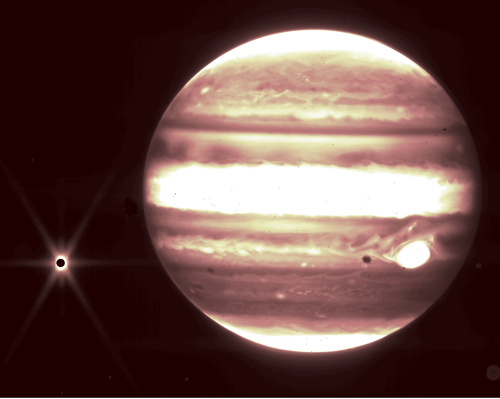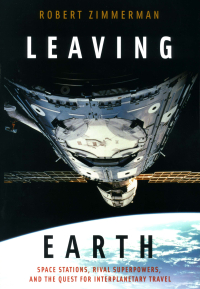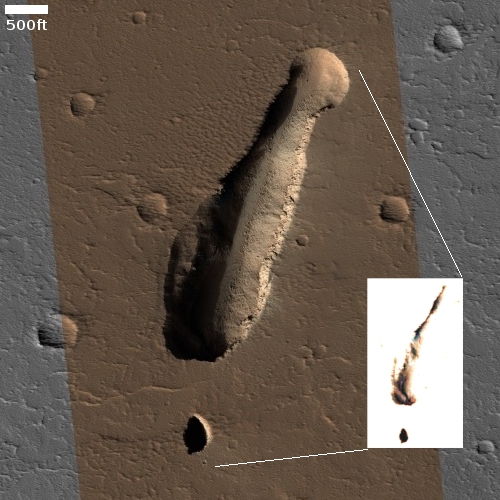Falcon 9 launches cargo Dragon to ISS
Capitalism in space: SpaceX tonight successfully used its Falcon 9 rocket to launch a Dragon freighter to ISS, with docking expected on July 16 at 11:20 am (Eastern).
The first stage landed successfully on a drone ship in the Atlantic, completing its fifth flight. The cargo Dragon is flying its third flight to the station.
The leaders in the 2022 launch race:
30 SpaceX
22 China
9 Russia
5 Rocket Lab
4 ULA
The U.S. now leads China 43 to 22 in the national rankings, and the entire globe combined 43 to 38.
Capitalism in space: SpaceX tonight successfully used its Falcon 9 rocket to launch a Dragon freighter to ISS, with docking expected on July 16 at 11:20 am (Eastern).
The first stage landed successfully on a drone ship in the Atlantic, completing its fifth flight. The cargo Dragon is flying its third flight to the station.
The leaders in the 2022 launch race:
30 SpaceX
22 China
9 Russia
5 Rocket Lab
4 ULA
The U.S. now leads China 43 to 22 in the national rankings, and the entire globe combined 43 to 38.
On Christmas Eve 1968 three Americans became the first humans to visit another world. What they did to celebrate was unexpected and profound, and will be remembered throughout all human history. Genesis: the Story of Apollo 8, Robert Zimmerman's classic history of humanity's first journey to another world, tells that story, and it is now available as both an ebook and an audiobook, both with a foreword by Valerie Anders and a new introduction by Robert Zimmerman.
The print edition can be purchased at Amazon or any other book seller. If you want an autographed copy the price is $60 for the hardback and $45 for the paperback, plus $8 shipping for each. Go here for purchasing details. The ebook is available everywhere for $5.99 (before discount) at amazon, or direct from my ebook publisher, ebookit you don't support the big tech companies and the author gets a bigger cut much sooner.
The audiobook is also available at all these vendors, and is also free with a 30-day trial membership to Audible.
"Not simply about one mission, [Genesis] is also the history of America's quest for the moon... Zimmerman has done a masterful job of tying disparate events together into a solid account of one of America's greatest human triumphs."--San Antonio Express-News
Webb infrared image of Jupiter & Europa
During the commissioning phase after deployment, the James Webb Space Telescope took images of Jupiter and several asteroids in order test the telescope’s instruments. The photo to the right, cropped and reduced to post here, shows both Jupiter and its moon Europa to the left.
Fans of Jupiter will recognize some familiar features of our solar system’s enormous planet in these images seen through Webb’s infrared gaze. A view from the NIRCam instrument’s short-wavelength filter shows distinct bands that encircle the planet as well as the Great Red Spot, a storm big enough to swallow the Earth. The iconic spot appears white in this image because of the way Webb’s infrared image was processed.
…Clearly visible at left is Europa, a moon with a probable ocean below its thick icy crust, and the target of NASA’s forthcoming Europa Clipper mission. What’s more, Europa’s shadow can be seen to the left of the Great Red Spot. Other visible moons in these images include Thebe and Metis.
The false color differences indicated differences in heat but it is not explained whether brighter is colder or warmer in this photo.. As one of my readers below correctly notes, Europa’s shadow tells us that darker is cooler. This one image shows that the Red Spot and Jupiter’s equatorial regions and poles are generally warm.
During the commissioning phase after deployment, the James Webb Space Telescope took images of Jupiter and several asteroids in order test the telescope’s instruments. The photo to the right, cropped and reduced to post here, shows both Jupiter and its moon Europa to the left.
Fans of Jupiter will recognize some familiar features of our solar system’s enormous planet in these images seen through Webb’s infrared gaze. A view from the NIRCam instrument’s short-wavelength filter shows distinct bands that encircle the planet as well as the Great Red Spot, a storm big enough to swallow the Earth. The iconic spot appears white in this image because of the way Webb’s infrared image was processed.
…Clearly visible at left is Europa, a moon with a probable ocean below its thick icy crust, and the target of NASA’s forthcoming Europa Clipper mission. What’s more, Europa’s shadow can be seen to the left of the Great Red Spot. Other visible moons in these images include Thebe and Metis.
The false color differences indicated differences in heat but it is not explained whether brighter is colder or warmer in this photo.. As one of my readers below correctly notes, Europa’s shadow tells us that darker is cooler. This one image shows that the Red Spot and Jupiter’s equatorial regions and poles are generally warm.
Today’s blacklisted American: University of California discriminates against everyone but American Indians

University of California: dedicated to the new segregation!
“Segregation today, segregation tomorrow, segregation forever!” The University of California has now joined with the University of Arizona in deciding that American Indians should be afforded special favored treatment above all other races and will therefore no longer have to pay tuition.
From the announcement letter [pdf], signed by the university’s president, Michael Drake:
Starting in Fall 2022, the University will ensure in-state systemwide Tuition and Student Services Fees are fully covered for California residents who are members of federally recognized Native American, American Indian, and Alaska Native tribes. This plan will be funded through a combination of existing State and University financial aid programs as well as other resources.
…The University of California is committed to recognizing and acknowledging historical wrongs endured by Native Americans. I am proud of the efforts the University has made to support the Native American community, including the creation of the UC Native American Opportunity Plan, and appreciate our conversations to date on all the ways in which we can better support Native American students. I am hopeful that this new program will benefit our students and continue to position the University of new program will benefit our students and continue to position the University of California as the institution of choice for Native American students. [emphasis mine]
For giving favored treatment to this special race of people, Drake has most generously decided that everyone else must pay for it:
» Read more

University of California: dedicated to the new segregation!
“Segregation today, segregation tomorrow, segregation forever!” The University of California has now joined with the University of Arizona in deciding that American Indians should be afforded special favored treatment above all other races and will therefore no longer have to pay tuition.
From the announcement letter [pdf], signed by the university’s president, Michael Drake:
Starting in Fall 2022, the University will ensure in-state systemwide Tuition and Student Services Fees are fully covered for California residents who are members of federally recognized Native American, American Indian, and Alaska Native tribes. This plan will be funded through a combination of existing State and University financial aid programs as well as other resources.
…The University of California is committed to recognizing and acknowledging historical wrongs endured by Native Americans. I am proud of the efforts the University has made to support the Native American community, including the creation of the UC Native American Opportunity Plan, and appreciate our conversations to date on all the ways in which we can better support Native American students. I am hopeful that this new program will benefit our students and continue to position the University of new program will benefit our students and continue to position the University of California as the institution of choice for Native American students. [emphasis mine]
For giving favored treatment to this special race of people, Drake has most generously decided that everyone else must pay for it:
» Read more
Now available in hardback and paperback as well as ebook!
From the press release: In this ground-breaking new history of early America, historian Robert Zimmerman not only exposes the lie behind The New York Times 1619 Project that falsely claims slavery is central to the history of the United States, he also provides profound lessons about the nature of human societies, lessons important for Americans today as well as for all future settlers on Mars and elsewhere in space.
Conscious Choice: The origins of slavery in America and why it matters today and for our future in outer space, is a riveting page-turning story that documents how slavery slowly became pervasive in the southern British colonies of North America, colonies founded by a people and culture that not only did not allow slavery but in every way were hostile to the practice.
Conscious Choice does more however. In telling the tragic history of the Virginia colony and the rise of slavery there, Zimmerman lays out the proper path for creating healthy societies in places like the Moon and Mars.
“Zimmerman’s ground-breaking history provides every future generation the basic framework for establishing new societies on other worlds. We would be wise to heed what he says.” —Robert Zubrin, founder of the Mars Society.
All editions are available at Amazon, Barnes & Noble, and all book vendors, with the ebook priced at $5.99 before discount. All editions can also be purchased direct from the ebook publisher, ebookit, in which case you don't support the big tech companies and the author gets a bigger cut much sooner.
Autographed printed copies are also available at discount directly from the author (hardback $29.95; paperback $14.95; Shipping cost for either: $6.00). Just send an email to zimmerman @ nasw dot org.
Comet K2: big and doing unexpected things
Link here. The article provides a nice overview of the observations so far of this very distant but very large comet making its suspected first close approach to the Sun this week, though still beyond the orbit of Mars and barely visible to amateurs.
K2 was first sighted in May 2017 at a much farther distance from the Sun than most comet discoveries. It had developed a coma much earlier than expected, which scientists now think came from from carbon monoxide.
“Carbon monoxide has been detected in other comets closer to the sun, although in much lower quantities than water. Carbon monoxide is very volatile and hard to freeze into a solid.” Jewitt and his colleagues theorized that as the comet slightly warmed while moving toward the planetary region of the solar system, the carbon monoxide ice near its surface turned into a gas that streamed into the vacuum of interplanetary space like constant wind. This wind stirred up dust particles from the comet’s surface, creating the round puffball-like coma.
But it took several failed attempts to measure the chemical composition of the comet to confirm the theory, Jewitt said. The team finally succeeded last year when the comet reached the orbit of Jupiter, and the scientists finally spotted carbon monoxide in the heart of the comet.
Comet K2 also did not develop a comet tail as expected. This appears to be because the particles in its coma are much larger than expected, something that at present is a complete puzzle.
Link here. The article provides a nice overview of the observations so far of this very distant but very large comet making its suspected first close approach to the Sun this week, though still beyond the orbit of Mars and barely visible to amateurs.
K2 was first sighted in May 2017 at a much farther distance from the Sun than most comet discoveries. It had developed a coma much earlier than expected, which scientists now think came from from carbon monoxide.
“Carbon monoxide has been detected in other comets closer to the sun, although in much lower quantities than water. Carbon monoxide is very volatile and hard to freeze into a solid.” Jewitt and his colleagues theorized that as the comet slightly warmed while moving toward the planetary region of the solar system, the carbon monoxide ice near its surface turned into a gas that streamed into the vacuum of interplanetary space like constant wind. This wind stirred up dust particles from the comet’s surface, creating the round puffball-like coma.
But it took several failed attempts to measure the chemical composition of the comet to confirm the theory, Jewitt said. The team finally succeeded last year when the comet reached the orbit of Jupiter, and the scientists finally spotted carbon monoxide in the heart of the comet.
Comet K2 also did not develop a comet tail as expected. This appears to be because the particles in its coma are much larger than expected, something that at present is a complete puzzle.
No more Ingenuity flights until August
Because it is now winter on Mars, with lots of seasonal dust in the atmosphere, the engineering team operating the helicopter Ingenuity have decided to suspend further flights until August.
Dust levels are expected to subside later in July, so the team has decided to give the helicopter’s batteries a break for a few weeks and build their daily state of charge back up. Weather permitting, Ingenuity is expected to be back in the air around the start of August.
This decision is not a surprise. When the team announced in May the plans for the helicopter’s most recent flight, completed in June, they suggested flights would pause for awhile thereafter. They have now made it official.
Because it is now winter on Mars, with lots of seasonal dust in the atmosphere, the engineering team operating the helicopter Ingenuity have decided to suspend further flights until August.
Dust levels are expected to subside later in July, so the team has decided to give the helicopter’s batteries a break for a few weeks and build their daily state of charge back up. Weather permitting, Ingenuity is expected to be back in the air around the start of August.
This decision is not a surprise. When the team announced in May the plans for the helicopter’s most recent flight, completed in June, they suggested flights would pause for awhile thereafter. They have now made it official.
Leaving Earth: Space Stations, Rival Superpowers, and the Quest for Interplanetary Travel, can be purchased as an ebook everywhere for only $3.99 (before discount) at amazon, Barnes & Noble, all ebook vendors, or direct from my ebook publisher, ebookit.
If you buy it from ebookit you don't support the big oppressive tech companies and I get a bigger cut much sooner.
Winner of the 2003 Eugene M. Emme Award of the American Astronautical Society.
"Leaving Earth is one of the best and certainly the most comprehensive summary of our drive into space that I have ever read. It will be invaluable to future scholars because it will tell them how the next chapter of human history opened." -- Arthur C. Clarke
New Hawaiian law takes control of Mauna Kea away from astronomers
A newly passed Hawaiian law has taken the management of the top of Mauna Kea away from the University of Hawaii and given it to a new community authority which will include many of the activists who have blocked the construction of the Thirty Meter Telescope (TMT).
The new Maunakea authority will include Native Hawaiians in decisions about how the mountain is managed, with an emphasis on mutual stewardship and protecting Maunakea for generations to come. The authority will have 11 voting members, one of whom must be an active practitioner of Native Hawaiian cultural traditions, and one of whom must be a descendant of a cultural practitioner who is associated with Maunakea. There are also spots for representatives drawn from astronomy, education, land management, politics and other fields.
“I’m very hopeful for the new entity,” says Noe Noe Wong-Wilson, a Native Hawaiian elder who has helped to lead road blocks on the mountain. “It is beyond my imagination of where we would be at this time, because we have fought so long to be heard.”
The University of Hawaii has managed most of the lands around the Maunakea summit since 1968, when the state granted it a 65-year lease to operate a scientific reserve focused on astronomy. Maunakea has ideal skies for astronomical observation, given its 4,200-metre height and its stable and dark night skies. The university now has to transfer all of its management duties, including a complex set of subleases, permits and other agreements, to the new authority by 1 July 2028. [emphasis mine]
From the beginning of the protesters against TMT I made several predictions, all of which are now coming true.
- This is a power play by some activist protesters for money and power. The new law gives them that.
- The Democratic Party that controls Hawaii utterly supports the protesters, and was working behind the scenes to aid them. The new law proves that.
- TMT will never be built. This new law makes that prediction almost certain.
- The real goal of the protesters will be the eventual shut down of all astronomy on Mauna Kea. This new law is the first step in that process.
Forget about TMT. It is dead, as are any new telescopes or upgrades on Mauna Kea. Sometime around 2028, when this new authority takes over, we shall begin to see demands for the removal of telescopes.
A newly passed Hawaiian law has taken the management of the top of Mauna Kea away from the University of Hawaii and given it to a new community authority which will include many of the activists who have blocked the construction of the Thirty Meter Telescope (TMT).
The new Maunakea authority will include Native Hawaiians in decisions about how the mountain is managed, with an emphasis on mutual stewardship and protecting Maunakea for generations to come. The authority will have 11 voting members, one of whom must be an active practitioner of Native Hawaiian cultural traditions, and one of whom must be a descendant of a cultural practitioner who is associated with Maunakea. There are also spots for representatives drawn from astronomy, education, land management, politics and other fields.
“I’m very hopeful for the new entity,” says Noe Noe Wong-Wilson, a Native Hawaiian elder who has helped to lead road blocks on the mountain. “It is beyond my imagination of where we would be at this time, because we have fought so long to be heard.”
The University of Hawaii has managed most of the lands around the Maunakea summit since 1968, when the state granted it a 65-year lease to operate a scientific reserve focused on astronomy. Maunakea has ideal skies for astronomical observation, given its 4,200-metre height and its stable and dark night skies. The university now has to transfer all of its management duties, including a complex set of subleases, permits and other agreements, to the new authority by 1 July 2028. [emphasis mine]
From the beginning of the protesters against TMT I made several predictions, all of which are now coming true.
- This is a power play by some activist protesters for money and power. The new law gives them that.
- The Democratic Party that controls Hawaii utterly supports the protesters, and was working behind the scenes to aid them. The new law proves that.
- TMT will never be built. This new law makes that prediction almost certain.
- The real goal of the protesters will be the eventual shut down of all astronomy on Mauna Kea. This new law is the first step in that process.
Forget about TMT. It is dead, as are any new telescopes or upgrades on Mauna Kea. Sometime around 2028, when this new authority takes over, we shall begin to see demands for the removal of telescopes.
July 13, 2022 Zimmerman/Batchelor podcast
Embedded below the fold in two parts.
To listen to all of John Batchelor’s podcasts, well worth your time, go here.
» Read more
Embedded below the fold in two parts.
To listen to all of John Batchelor’s podcasts, well worth your time, go here.
» Read more
Bobby Goldsboro – Honey
How the localized nature of Democrat vote tampering will influence the 2022 election
Based on the ample evidence of election fraud, corruption, and vote tampering done repeatedly by Democrats nationwide during the 2020 election, we can expect these politicians and their minions to commit similar election crimes in the upcoming 2022 mid-term elections, especially because the effort by some Republicans to reform their state election systems in the key purple states was so effectively blocked by Democrats, by many quisling Republicans, and by a willing leftist press.
It is however important to understand where that election tampering was done in 2020 in order to understand the election fraud to come, as well as creating a strategy to prevent it. As real estate agents like to say, “Location is everything!”, and it appears this applies to election fraud as well.

The 2020 fraud in Democratically-controlled Fulton County (Atlanta), Georgia.
In 2020, in states that were purple and where the final result was in doubt, the Democrats took advantage of their total control of the local urban voting districts in those states — where there are very few Republican voters — to tilt the results. In such places (Philadelphia, New York, Atlanta, Detroit, Phoenix) the government is essentially a one-party Democrat operation. Many election districts in these cities have no Republican election judges at all. If the Democrats wish to commit election fraud, there is no one looking over their shoulder to question them, with some districts actually taking aggressive action in 2020 to illegally keep Republican poll watchers out.
Thus we saw strong evidence in all of these cities of pro-Democrat ballot-stuffing, of all types, from fake ballots to ballots counted multiple times to evidence the votes on the ballots themselves were changed by computer. The fraud however was strongly localized to these urban centers controlled by Democrats. The vote tampering was able to tilt the statewide results. but not the local contests.
For example, Democrat mayors in Wisconsin teamed up to have drop boxes placed illegally in unsupervised locations, where Democratic Party mules could stuff them with thousands of harvested ballots. The Wisconsin Supreme Court finally ruled on July 8, 2022 that these boxes were illegal, and violated the plain language of the state’s election laws:
» Read more
July 12, 2022 Zimmerman/Bartholomew podcast
I did a short twelve minute segment with Bill Bartholomew on the radio in Rhode Island yesterday, which I have embedded below. The subject was the James Webb Space Telescope. While discussing the scientific importance of its images, Bill also allowed me to explain why overall the $10 billion cost and twenty-year development of this telescope was a mistake, and that had the money been better used — building many smaller space telescopes — astronomy would have likely learned much more sooner.
I did a short twelve minute segment with Bill Bartholomew on the radio in Rhode Island yesterday, which I have embedded below. The subject was the James Webb Space Telescope. While discussing the scientific importance of its images, Bill also allowed me to explain why overall the $10 billion cost and twenty-year development of this telescope was a mistake, and that had the money been better used — building many smaller space telescopes — astronomy would have likely learned much more sooner.
Icy scarps in the high southern latitudes of Mars
Cool image time! The photo to the right, rotated, cropped, and reduced to post here, was taken on May 30, 2022 by the high resolution camera on Mars Reconnaissance Orbiter (MRO). It shows what the scientists label “Patching Mantling Unit,” located at about 57 degrees south latitude in a region where scientists have found good evidence of near surface ice. The top layer, or mantle, is likely patchy because it has a high content of water ice and is sublimating away. That almost all the cliffs are south-facing, which in the southern hemisphere gets the least direct sunlight, supports this supposition. For example, in the crater at the bottom of the image the ice would have disappeared first from the north-facing interior rim slopes, with the sublimation slowly working its way northward. Thus we have that butte extending out from the north rim.
The global map below not only indicates the location of these scallops with the green dot, it illustrates the overall icy nature of most of the Mars.
» Read more
Cool image time! The photo to the right, rotated, cropped, and reduced to post here, was taken on May 30, 2022 by the high resolution camera on Mars Reconnaissance Orbiter (MRO). It shows what the scientists label “Patching Mantling Unit,” located at about 57 degrees south latitude in a region where scientists have found good evidence of near surface ice. The top layer, or mantle, is likely patchy because it has a high content of water ice and is sublimating away. That almost all the cliffs are south-facing, which in the southern hemisphere gets the least direct sunlight, supports this supposition. For example, in the crater at the bottom of the image the ice would have disappeared first from the north-facing interior rim slopes, with the sublimation slowly working its way northward. Thus we have that butte extending out from the north rim.
The global map below not only indicates the location of these scallops with the green dot, it illustrates the overall icy nature of most of the Mars.
» Read more
Pushback: Doctor blacklisted by Twitter for citing peer-reviewed research threatens lawsuit

UPDATE: One day after this post was published, Twitter reinstated Bostom’s account, admitting he broke no rules. As Bostom noted in response, ““Twitter’s arbitrary COVID-19 Lysenkoism must cease, permanently.”
Bring a gun to a knife fight: Doctor and researcher Andrew Bostom, who was blacklisted by Twitter in June simply because he cited a peer-reviewed research paper that suggested the COVID shots impaired semen production, has now retained the same lawyer who successfully forced Twitter to reinstate Alex Berenson’s account after he had been similarly blackballed.
The banned tweet and Twitter’s account suspension are shown in the screen capture to the right. As Bostom notes at the first link above:
The tweet in question contained data from a recent peer reviewed publication in the journal Andrology, with the eponymous title, “Covid-19 vaccination BNT162b2 temporarily impairs semen concentration and total motile count among semen donors”.
The Journal Andrology is highly respected and published through a joint effort of American and European scientific associations, The study was a straightforward, serial analysis of young male Israeli semen donors evaluating the potential impact of Pfizer’s covid-19 mRNA vaccine on their sperm concentration (count), and related functional measures.
Berenson had been banned by Twitter for a similar tweet that summarized these obvious and now well documented facts about the COVID shots:
“It doesn’t stop infection. Or transmission,” he wrote. “Don’t think of it as a vaccine. Think of it – at best – as a therapeutic with a limited window of efficacy and terrible side effect profile that must be dosed IN ADVANCE OF ILLNESS.”
After more than a year, Berenson’s Twitter account was finally reinstated, with Twitter admitting that he had said nothing wrong and should not have been banned. The details of the settlement are under seal, so we do not know if Berenson also received monetary damages from Twitter.
The lawyer who represented him is now representing Bostom in an almost identical case. Bostom’s account shouldn’t simply be reinstated. Twitter should suffer some financial penalty for the improper banning, since it acted to limit the public distribution of his work, and likely caused him some financial loss.
Bostom is not only pushing back against Twitter’s blackballing. He has also exposing Brown University’s effort to hide the negative health effects of its COVID shot mandate on its students. According to Bostom’s research:
» Read more

UPDATE: One day after this post was published, Twitter reinstated Bostom’s account, admitting he broke no rules. As Bostom noted in response, ““Twitter’s arbitrary COVID-19 Lysenkoism must cease, permanently.”
Bring a gun to a knife fight: Doctor and researcher Andrew Bostom, who was blacklisted by Twitter in June simply because he cited a peer-reviewed research paper that suggested the COVID shots impaired semen production, has now retained the same lawyer who successfully forced Twitter to reinstate Alex Berenson’s account after he had been similarly blackballed.
The banned tweet and Twitter’s account suspension are shown in the screen capture to the right. As Bostom notes at the first link above:
The tweet in question contained data from a recent peer reviewed publication in the journal Andrology, with the eponymous title, “Covid-19 vaccination BNT162b2 temporarily impairs semen concentration and total motile count among semen donors”.
The Journal Andrology is highly respected and published through a joint effort of American and European scientific associations, The study was a straightforward, serial analysis of young male Israeli semen donors evaluating the potential impact of Pfizer’s covid-19 mRNA vaccine on their sperm concentration (count), and related functional measures.
Berenson had been banned by Twitter for a similar tweet that summarized these obvious and now well documented facts about the COVID shots:
“It doesn’t stop infection. Or transmission,” he wrote. “Don’t think of it as a vaccine. Think of it – at best – as a therapeutic with a limited window of efficacy and terrible side effect profile that must be dosed IN ADVANCE OF ILLNESS.”
After more than a year, Berenson’s Twitter account was finally reinstated, with Twitter admitting that he had said nothing wrong and should not have been banned. The details of the settlement are under seal, so we do not know if Berenson also received monetary damages from Twitter.
The lawyer who represented him is now representing Bostom in an almost identical case. Bostom’s account shouldn’t simply be reinstated. Twitter should suffer some financial penalty for the improper banning, since it acted to limit the public distribution of his work, and likely caused him some financial loss.
Bostom is not only pushing back against Twitter’s blackballing. He has also exposing Brown University’s effort to hide the negative health effects of its COVID shot mandate on its students. According to Bostom’s research:
» Read more
Ariane-6 mock-up installed at launchpad for tests
The European Space Agency yesterday announced that it has installed an Ariane-6 full scale mock-up at its launchpad in French Guiana in preparation for tank and launch procedure tests.
The Ariane 6 combined tests model is highly representative of the flight model. It consists of the core stage and the upper stage, which make up the central core, as well as three pylons shaped like the rocket’s solid boosters and a fully representative but inert mockup of the fourth booster.
The Ariane 6 combined tests model central core was precisely mated in the purpose-built launcher assembly building, where this task is carried out horizontally. Automated guidance vehicles then brought the assembled core to the launch and, working with the crane at the mobile gantry, raised it to its vertical position.
The date of the actual first launch has not been announced, though ESA has officially admitted that it will not occur this year as hoped.
The European Space Agency yesterday announced that it has installed an Ariane-6 full scale mock-up at its launchpad in French Guiana in preparation for tank and launch procedure tests.
The Ariane 6 combined tests model is highly representative of the flight model. It consists of the core stage and the upper stage, which make up the central core, as well as three pylons shaped like the rocket’s solid boosters and a fully representative but inert mockup of the fourth booster.
The Ariane 6 combined tests model central core was precisely mated in the purpose-built launcher assembly building, where this task is carried out horizontally. Automated guidance vehicles then brought the assembled core to the launch and, working with the crane at the mobile gantry, raised it to its vertical position.
The date of the actual first launch has not been announced, though ESA has officially admitted that it will not occur this year as hoped.
Roscosmos forbids its astronauts from using Europe’s robot arm
In response to the final decision this week by the European Space Agency to officially end its cooperation with Russia on its ExoMars mission, Roscosmos today forbid its astronauts from using Europe’s new robot arm that was recently installed on the Russian Nauka module of ISS.
Russia’s crew onboard the International Space Station (ISS) will stop using the European ERA manipulator arm in response to the European Space Agency’s (ESA) refusal from cooperation on the ExoMars project, CEO of Russia’s state space corporation Roscosmos Dmitry Rogozin said on Tuesday.
“In my turn, I instruct our ISS crew to stop using the European Robotic Arm (ERA). Let [ESA Director General Josef] Aschbacher along with his boss [EU foreign policy chief Josep] Borrell fly to space and do at least something useful in their entire lives,” he wrote on his Telegram channel.
The arm was designed to work on the Russian part of ISS, so it appears this decision by Rogozin is an example of someone cutting off his nose to spite his face. It essentially reduces Russia’s capabilities on the station.
As for ExoMars, it is unclear what will happen to the lander that Russia built to put Europe’s Franklin rover on Mars. Roscosmos has said it might proceed with its own mission to Mars, using that lander, but it has not made the full commitment to do so.
In response to the final decision this week by the European Space Agency to officially end its cooperation with Russia on its ExoMars mission, Roscosmos today forbid its astronauts from using Europe’s new robot arm that was recently installed on the Russian Nauka module of ISS.
Russia’s crew onboard the International Space Station (ISS) will stop using the European ERA manipulator arm in response to the European Space Agency’s (ESA) refusal from cooperation on the ExoMars project, CEO of Russia’s state space corporation Roscosmos Dmitry Rogozin said on Tuesday.
“In my turn, I instruct our ISS crew to stop using the European Robotic Arm (ERA). Let [ESA Director General Josef] Aschbacher along with his boss [EU foreign policy chief Josep] Borrell fly to space and do at least something useful in their entire lives,” he wrote on his Telegram channel.
The arm was designed to work on the Russian part of ISS, so it appears this decision by Rogozin is an example of someone cutting off his nose to spite his face. It essentially reduces Russia’s capabilities on the station.
As for ExoMars, it is unclear what will happen to the lander that Russia built to put Europe’s Franklin rover on Mars. Roscosmos has said it might proceed with its own mission to Mars, using that lander, but it has not made the full commitment to do so.
ABL completes static fire test of first stage of its new RS1 rocket
Capitalism in space: The new smallsat rocket startup ABL has successfully completed a full static fire test of the first stage of its new RS1 rocket from its launchpad in Kodiak, Alaska.
Company executives said that they performed the static-fire test of the first stage of its RS1 rocket July 9 at the Pacific Spaceport Complex – Alaska on Kodiak Island, the site where the company plans to conduct its first launch.
“The operation verified our startup sequence and stage level engine performance,” Harry O’Hanley, chief executive of ABL, said in a statement to SpaceNews. “A testament to our team’s intense preparation, we completed the test on the first attempt.”
The static-fire test also verified the performance of the ground systems, including a portable launch stool that can be packed into a shipping container. That system, O’Hanley said, enables launching from a flat pad like at Kodiak.
The company is presently completing testing of the rocket’s upper stage, with its next task to mate the two and complete a full dress rehearsal countdown. Though no launch date has been set, the company has been targeting a launch before the end of this year.
Capitalism in space: The new smallsat rocket startup ABL has successfully completed a full static fire test of the first stage of its new RS1 rocket from its launchpad in Kodiak, Alaska.
Company executives said that they performed the static-fire test of the first stage of its RS1 rocket July 9 at the Pacific Spaceport Complex – Alaska on Kodiak Island, the site where the company plans to conduct its first launch.
“The operation verified our startup sequence and stage level engine performance,” Harry O’Hanley, chief executive of ABL, said in a statement to SpaceNews. “A testament to our team’s intense preparation, we completed the test on the first attempt.”
The static-fire test also verified the performance of the ground systems, including a portable launch stool that can be packed into a shipping container. That system, O’Hanley said, enables launching from a flat pad like at Kodiak.
The company is presently completing testing of the rocket’s upper stage, with its next task to mate the two and complete a full dress rehearsal countdown. Though no launch date has been set, the company has been targeting a launch before the end of this year.
OneWeb agrees with SpaceX: Dish’s ground-based plans a frequency threat
Capitalism in space: In a filing with the FCC, OneWeb has come out in full agreement with its competitor SpaceX, stating that Dish’s proposal to use the 12 GHz wavelength would threaten its satellite communications.
In a letter to the Federal Communications Commission, OneWeb urged the regulator to reject a request from satellite broadcaster Dish Network and spectrum holder RS Access to run two-way mobile services in the band. If approved, “it would leave significant areas of the United States unusable by the otherwise ubiquitous NGSO [fixed satellite service] user terminals,” wrote Kimberly Baum, OneWeb’s vice president of spectrum engineering and strategy.
To connect user terminals, the SpaceX-owned Starlink and OneWeb megaconstellations use a satellite downlink band that extends from 10.7 GHz to 12.7 GHz. The analysis from OneWeb is the latest in a string of studies assessing how a high-power mobile network in the 12.2-12.7 GHz band would impact NGSO services.
Though the FCC has not yet made a final decision, it has already rejected Dish network’s request to block SpaceX’s use with Starlink of these wavelengths.
Capitalism in space: In a filing with the FCC, OneWeb has come out in full agreement with its competitor SpaceX, stating that Dish’s proposal to use the 12 GHz wavelength would threaten its satellite communications.
In a letter to the Federal Communications Commission, OneWeb urged the regulator to reject a request from satellite broadcaster Dish Network and spectrum holder RS Access to run two-way mobile services in the band. If approved, “it would leave significant areas of the United States unusable by the otherwise ubiquitous NGSO [fixed satellite service] user terminals,” wrote Kimberly Baum, OneWeb’s vice president of spectrum engineering and strategy.
To connect user terminals, the SpaceX-owned Starlink and OneWeb megaconstellations use a satellite downlink band that extends from 10.7 GHz to 12.7 GHz. The analysis from OneWeb is the latest in a string of studies assessing how a high-power mobile network in the 12.2-12.7 GHz band would impact NGSO services.
Though the FCC has not yet made a final decision, it has already rejected Dish network’s request to block SpaceX’s use with Starlink of these wavelengths.
Rocket Lab & ESA complete launches
Very early today from New Zealand Rocket Lab successfully launched the first of two quickly scheduled launches for the National Reconnaissance Office, designed to demonstrate its ability to achieve fast scheduling and rapid turnaround. The second launch is targeting July 22, 2022, only ten days later.
Also today the European Space Agency (ESA) successfully completed the first launch of its new upgraded Vega-C rocket, putting its prime payload (a passive test satellite) plus six cubesats into orbit. Though ESA says it will eventually hand over operations to Arianespace, its commercial arm, the rocket itself is mostly built by the Italian company Avio. Also, the rocket’s solid rocket first stage will be used as an optional side booster on the Ariane-6 rocket ArianeGroup is building for ESA.
Though ESA launched Vega-C, as it will eventually be managed by Arianespace I include it in that company’s total, which is now three launches for 2022.
The leaders in the 2022 launch race:
29 SpaceX
22 China
9 Russia
5 Rocket Lab
4 ULA
American private enterprise. now leads China 42 to 22 in the national rankings, and the entire globe 42 to 38.
Very early today from New Zealand Rocket Lab successfully launched the first of two quickly scheduled launches for the National Reconnaissance Office, designed to demonstrate its ability to achieve fast scheduling and rapid turnaround. The second launch is targeting July 22, 2022, only ten days later.
Also today the European Space Agency (ESA) successfully completed the first launch of its new upgraded Vega-C rocket, putting its prime payload (a passive test satellite) plus six cubesats into orbit. Though ESA says it will eventually hand over operations to Arianespace, its commercial arm, the rocket itself is mostly built by the Italian company Avio. Also, the rocket’s solid rocket first stage will be used as an optional side booster on the Ariane-6 rocket ArianeGroup is building for ESA.
Though ESA launched Vega-C, as it will eventually be managed by Arianespace I include it in that company’s total, which is now three launches for 2022.
The leaders in the 2022 launch race:
29 SpaceX
22 China
9 Russia
5 Rocket Lab
4 ULA
American private enterprise. now leads China 42 to 22 in the national rankings, and the entire globe 42 to 38.
Molly Tuttle & Golden Highway – She’ll Change
China launches another communications satellite for its space program
Using its Long March 3B rocket, China today launched the third satellite in the second generation of communication satellites used by its space program.
All told China now has seven satellites in this constellation, giving it a great deal of redundancy.
The leaders in the 2022 launch race:
29 SpaceX
22 China
9 Russia
4 Rocket Lab
4 ULA
American private enterprise still leads China 41 to 22 in the national rankings, and the entire world 41 to 37.
Using its Long March 3B rocket, China today launched the third satellite in the second generation of communication satellites used by its space program.
All told China now has seven satellites in this constellation, giving it a great deal of redundancy.
The leaders in the 2022 launch race:
29 SpaceX
22 China
9 Russia
4 Rocket Lab
4 ULA
American private enterprise still leads China 41 to 22 in the national rankings, and the entire world 41 to 37.
The highest point on Mars
Today’s cool image is cool not because of anything visible within it, but because of its location. The picture to the right, cropped to post here, was taken on May 27, 2022 by the high resolution camera on Mars Reconnaissance Orbiter (MRO). While the terrain shown is a relatively featureless plain of craters and gullies not unlike the surface of the Moon, what we are really looking at is the peak of Mars’ tallest mountain, Olympus Mons.
That’s right, this spot on Mars sits about 70,000 feet above Mars’ mean “sea level”, the elevation scientists have chosen as the average elevation on Mars from its center. At 70,000 feet, this peak is more than twice as high as Mount Everest on Earth.
Yet you wouldn’t really know you are at this height if you stood there. The scale of this mountain is so large that this peak, which actually forms the southern rim of the volcano’s 50 to 60 mile wide caldera, is actually relatively flat. If you stood here, you would not see the vast distant terrain far below. Instead, you’d see an ordinary horizon line in the near distance only slightly lower than where you stand.
» Read more
Today’s cool image is cool not because of anything visible within it, but because of its location. The picture to the right, cropped to post here, was taken on May 27, 2022 by the high resolution camera on Mars Reconnaissance Orbiter (MRO). While the terrain shown is a relatively featureless plain of craters and gullies not unlike the surface of the Moon, what we are really looking at is the peak of Mars’ tallest mountain, Olympus Mons.
That’s right, this spot on Mars sits about 70,000 feet above Mars’ mean “sea level”, the elevation scientists have chosen as the average elevation on Mars from its center. At 70,000 feet, this peak is more than twice as high as Mount Everest on Earth.
Yet you wouldn’t really know you are at this height if you stood there. The scale of this mountain is so large that this peak, which actually forms the southern rim of the volcano’s 50 to 60 mile wide caldera, is actually relatively flat. If you stood here, you would not see the vast distant terrain far below. Instead, you’d see an ordinary horizon line in the near distance only slightly lower than where you stand.
» Read more
Today’s blacklisted American: Scientists questioning Big Bang theory protest censorship of their work

Nothing in Webb’s first deep field image shall be questioned, by anyone!
While the blacklisting described in today’s column has little to do with left vs right politics, it demonstrates clearly that the desire to silence dissent is now culturally pervasive across many fields. In science it has become especially toxic, as this story clearly shows:
Twenty-four astronomers and physicists from ten countries have signed a petition protesting the censorship of papers that are critical of the Big Bang Hypothesis by the open pre-print website arXiv. Run by Cornell University, arXiv is supposed to provide an open public forum for researchers to exchange pre-publication papers, without peer-review. But during June, 2022, arXiv rejected for publication on the website three papers by Dr. Riccardo Scarpa, Instituto de Astrofisica de Canarias, and Eric J. Lerner, LPPFusion, Inc. which are critical of the validity of the Big Bang hypothesis.
…[quoting the petition] “Without judging the scientific validity of the papers, it is clear to us that these papers are both original and substantive and are of interest to all those concerned with the current crisis in cosmology. It plainly appears that arXiv has refused publication to these papers only because of their conclusions, which both provide specific predictions relevant to forthcoming observations and challenge LCDM cosmology [the standard dark matter/dark energy Big Bang hypothesis]. Such censorship is anathema to scientific discourse and to the possibility of scientific advance.
“We strongly urge that arXiv maintain its long-standing practice of being an “open-access archive” of non-peer reviewed “scholarly articles” and not violate that worthy practice by imposing any censorship. Instead, we encourage arXiv to abide by its own principles, and publish these three papers and others like them that clearly provide ‘sufficient original or substantive scholarly research’ results and are of obvious great interest to the arXiv audience.”
Lerner and Scarpa had attempted to get their papers published in a peer review journal and had been stymied, apparently because the topic of their paper was inappropriate for that journal. They then decided to publish on arXiv, which has for almost three decades been open to the publication of all scientific papers written by credentialed scientists, as noted at the website:
» Read more

Nothing in Webb’s first deep field image shall be questioned, by anyone!
While the blacklisting described in today’s column has little to do with left vs right politics, it demonstrates clearly that the desire to silence dissent is now culturally pervasive across many fields. In science it has become especially toxic, as this story clearly shows:
Twenty-four astronomers and physicists from ten countries have signed a petition protesting the censorship of papers that are critical of the Big Bang Hypothesis by the open pre-print website arXiv. Run by Cornell University, arXiv is supposed to provide an open public forum for researchers to exchange pre-publication papers, without peer-review. But during June, 2022, arXiv rejected for publication on the website three papers by Dr. Riccardo Scarpa, Instituto de Astrofisica de Canarias, and Eric J. Lerner, LPPFusion, Inc. which are critical of the validity of the Big Bang hypothesis.
…[quoting the petition] “Without judging the scientific validity of the papers, it is clear to us that these papers are both original and substantive and are of interest to all those concerned with the current crisis in cosmology. It plainly appears that arXiv has refused publication to these papers only because of their conclusions, which both provide specific predictions relevant to forthcoming observations and challenge LCDM cosmology [the standard dark matter/dark energy Big Bang hypothesis]. Such censorship is anathema to scientific discourse and to the possibility of scientific advance.
“We strongly urge that arXiv maintain its long-standing practice of being an “open-access archive” of non-peer reviewed “scholarly articles” and not violate that worthy practice by imposing any censorship. Instead, we encourage arXiv to abide by its own principles, and publish these three papers and others like them that clearly provide ‘sufficient original or substantive scholarly research’ results and are of obvious great interest to the arXiv audience.”
Lerner and Scarpa had attempted to get their papers published in a peer review journal and had been stymied, apparently because the topic of their paper was inappropriate for that journal. They then decided to publish on arXiv, which has for almost three decades been open to the publication of all scientific papers written by credentialed scientists, as noted at the website:
» Read more
India inaugurates its own space debris tracking facility
ISRO, India’s government space agency, today inaugurated its own space debris tracking facility, designed to track space junk much as the Space Force does in the U.S.
A new facility dubbed the System for Safe & Sustainable Operation has been inaugurated in Bengaluru that will deal with emerging threats from space debris.
The new facility will help India achieve its Space Situational Awareness (SSA) goals by providing comprehensive and timely information about the space environment. The system will alert the agency about probabilities of in-orbit collisions, fragmentation, atmospheric re-entry risk, space-based strategic information, hazardous asteroids and space weather forecasts.
Though China might have its own comparable facility, I am unsure. Even if it does, the U.S. military has been for decades the only nation that does this tracking and then provides the data to the world, at no cost. That India is now developing its own capability signals that nation’s desire to chart its own path in space that does not depend on the resources of others.
This facility also signals the shift in ISRO’s job. Before, this government agency built and owned India’s rockets, flying commercial missions for profit. Now, the Modi government wants to transfer those tasks to India’s private sector, with ISRO merely acting as a customer if it needs such services. This change however will reduce ISRO’s influence, something that factions within India’s government are resisting. By giving ISRO the new task of tracking space debris, the Modi government gives ISRO new responsibilities to replace the ones it is losing. This will ease the turf war and speed the transition to a competing commercial industry.
ISRO, India’s government space agency, today inaugurated its own space debris tracking facility, designed to track space junk much as the Space Force does in the U.S.
A new facility dubbed the System for Safe & Sustainable Operation has been inaugurated in Bengaluru that will deal with emerging threats from space debris.
The new facility will help India achieve its Space Situational Awareness (SSA) goals by providing comprehensive and timely information about the space environment. The system will alert the agency about probabilities of in-orbit collisions, fragmentation, atmospheric re-entry risk, space-based strategic information, hazardous asteroids and space weather forecasts.
Though China might have its own comparable facility, I am unsure. Even if it does, the U.S. military has been for decades the only nation that does this tracking and then provides the data to the world, at no cost. That India is now developing its own capability signals that nation’s desire to chart its own path in space that does not depend on the resources of others.
This facility also signals the shift in ISRO’s job. Before, this government agency built and owned India’s rockets, flying commercial missions for profit. Now, the Modi government wants to transfer those tasks to India’s private sector, with ISRO merely acting as a customer if it needs such services. This change however will reduce ISRO’s influence, something that factions within India’s government are resisting. By giving ISRO the new task of tracking space debris, the Modi government gives ISRO new responsibilities to replace the ones it is losing. This will ease the turf war and speed the transition to a competing commercial industry.
More Webb images released
As planned, NASA this morning released four new science images from the James Webb Space Telescope, in addition to the deep field image released yesterday.
All are spectacular, with each producing new information not previously observed. To see the Stephen’s Quintet image go here. For the exoplanet data, showing the presence of water in its atmosphere, go here. For the Carina nebula image, go here.
The image to the right, reduced to post here, shows the Southern Ring Nebula as taken by two Webb cameras in different infrared wavelengths. From the press release:
Two stars, which are locked in a tight orbit, shape the local landscape. Webb’s infrared images feature new details in this complex system. The stars – and their layers of light – are prominent in the image from Webb’s Near-Infrared Camera (NIRCam) [at the top], while the image from Webb’s Mid-Infrared Instrument (MIRI) on the [bottom] shows for the first time that the second star is surrounded by dust. The brighter star is in an earlier stage of its stellar evolution and will probably eject its own planetary nebula in the future.
In the meantime, the brighter star influences the nebula’s appearance. As the pair continues to orbit one another, they “stir the pot” of gas and dust, causing asymmetrical patterns.
Because this is an infrared image, the colors are not natural, but were assigned based on the slightly different infrared wavelengths produced by the object’s different features. From the image’s webpage:
Several filters were used to sample narrow and broad wavelength ranges. The color results from assigning different hues (colors) to each monochromatic (grayscale) image associated with an individual filter.
Eventually astronomers will use Webb to look at many astronomical objects that Hubble has been observing for the past thirty years, adding a high resolution infrared view that will add to Hubble’s views.
As planned, NASA this morning released four new science images from the James Webb Space Telescope, in addition to the deep field image released yesterday.
All are spectacular, with each producing new information not previously observed. To see the Stephen’s Quintet image go here. For the exoplanet data, showing the presence of water in its atmosphere, go here. For the Carina nebula image, go here.
The image to the right, reduced to post here, shows the Southern Ring Nebula as taken by two Webb cameras in different infrared wavelengths. From the press release:
Two stars, which are locked in a tight orbit, shape the local landscape. Webb’s infrared images feature new details in this complex system. The stars – and their layers of light – are prominent in the image from Webb’s Near-Infrared Camera (NIRCam) [at the top], while the image from Webb’s Mid-Infrared Instrument (MIRI) on the [bottom] shows for the first time that the second star is surrounded by dust. The brighter star is in an earlier stage of its stellar evolution and will probably eject its own planetary nebula in the future.
In the meantime, the brighter star influences the nebula’s appearance. As the pair continues to orbit one another, they “stir the pot” of gas and dust, causing asymmetrical patterns.
Because this is an infrared image, the colors are not natural, but were assigned based on the slightly different infrared wavelengths produced by the object’s different features. From the image’s webpage:
Several filters were used to sample narrow and broad wavelength ranges. The color results from assigning different hues (colors) to each monochromatic (grayscale) image associated with an individual filter.
Eventually astronomers will use Webb to look at many astronomical objects that Hubble has been observing for the past thirty years, adding a high resolution infrared view that will add to Hubble’s views.
Superheavy prototype #7 explodes during tanking test
Capitalism in space: SpaceX’s Superheavy prototype #7 exploded yesterday during a tanking test in Boca Chica, Texas.
I have embedded the video of the explosion below, cued to just before it occurred.
According to Musk, the engineering teams are presently assessing damage. The booster itself appeared relatively intact afterward, though leaning slightly to one side.
At a minimum this incident will delay the orbital launch attempt, especially if booster #7 must be replaced with booster #8, already being prepped in the assembly building nearby.
Capitalism in space: SpaceX’s Superheavy prototype #7 exploded yesterday during a tanking test in Boca Chica, Texas.
I have embedded the video of the explosion below, cued to just before it occurred.
According to Musk, the engineering teams are presently assessing damage. The booster itself appeared relatively intact afterward, though leaning slightly to one side.
At a minimum this incident will delay the orbital launch attempt, especially if booster #7 must be replaced with booster #8, already being prepped in the assembly building nearby.
Jonny Lang – Rack ’em up
First science image released from Webb
The first science image from the James Webb Space Telescope has now been unveiled.
That image is to the right, reduced to post here. From the press release:
Known as Webb’s First Deep Field, this image of galaxy cluster SMACS 0723 is overflowing with detail. Thousands of galaxies – including the faintest objects ever observed in the infrared – have appeared in Webb’s view for the first time. This slice of the vast universe covers a patch of sky approximately the size of a grain of sand held at arm’s length by someone on the ground.
This deep field, taken by Webb’s Near-Infrared Camera (NIRCam), is a composite made from images at different wavelengths, totaling 12.5 hours – achieving depths at infrared wavelengths beyond the Hubble Space Telescope’s deepest fields, which took weeks.
The image shows the galaxy cluster SMACS 0723 as it appeared 4.6 billion years ago. The combined mass of this galaxy cluster acts as a gravitational lens, magnifying much more distant galaxies behind it. Webb’s NIRCam has brought those distant galaxies into sharp focus – they have tiny, faint structures that have never been seen before, including star clusters and diffuse features.
The smeared concentric arrangement of many reddish objects surrounding the picture’s center strongly suggests we are seeing distortion by the gravity of this galaxy cluster.
While nothing in this image appears at first glance to be different than many earlier Hubble images, it looks at objects in the infrared that are much farther away than anything ever seen before, farther than Hubble in the optical could see. To understand the new discoveries hidden in such an image will likely take several years of further research. For example, before astronomers can understand what this image shows they need to determine the red shift of each galaxy, thus roughly determining its distance and the overall 3D structure of the objects visible. Moreover, the consequences of the gravitational lensing must be unpacked.
The White House briefing itself was somewhat embarrassing to watch, as Vice President Kamala Harris, President Joe Biden, and NASA administrator Bill Nelson all struggled to explain what this image shows, and failed miserably. Moreover, the briefing had technical problems, started very late, and it appeared that Bill Nelson especially had no idea what he was looking at. The briefing also ended very abruptly when it shifted to reporters’ questions.
The first science image from the James Webb Space Telescope has now been unveiled.
That image is to the right, reduced to post here. From the press release:
Known as Webb’s First Deep Field, this image of galaxy cluster SMACS 0723 is overflowing with detail. Thousands of galaxies – including the faintest objects ever observed in the infrared – have appeared in Webb’s view for the first time. This slice of the vast universe covers a patch of sky approximately the size of a grain of sand held at arm’s length by someone on the ground.
This deep field, taken by Webb’s Near-Infrared Camera (NIRCam), is a composite made from images at different wavelengths, totaling 12.5 hours – achieving depths at infrared wavelengths beyond the Hubble Space Telescope’s deepest fields, which took weeks.
The image shows the galaxy cluster SMACS 0723 as it appeared 4.6 billion years ago. The combined mass of this galaxy cluster acts as a gravitational lens, magnifying much more distant galaxies behind it. Webb’s NIRCam has brought those distant galaxies into sharp focus – they have tiny, faint structures that have never been seen before, including star clusters and diffuse features.
The smeared concentric arrangement of many reddish objects surrounding the picture’s center strongly suggests we are seeing distortion by the gravity of this galaxy cluster.
While nothing in this image appears at first glance to be different than many earlier Hubble images, it looks at objects in the infrared that are much farther away than anything ever seen before, farther than Hubble in the optical could see. To understand the new discoveries hidden in such an image will likely take several years of further research. For example, before astronomers can understand what this image shows they need to determine the red shift of each galaxy, thus roughly determining its distance and the overall 3D structure of the objects visible. Moreover, the consequences of the gravitational lensing must be unpacked.
The White House briefing itself was somewhat embarrassing to watch, as Vice President Kamala Harris, President Joe Biden, and NASA administrator Bill Nelson all struggled to explain what this image shows, and failed miserably. Moreover, the briefing had technical problems, started very late, and it appeared that Bill Nelson especially had no idea what he was looking at. The briefing also ended very abruptly when it shifted to reporters’ questions.
Collapse pits on Mars
Cool image time! The photo to the right, cropped to post here, was taken on May 21, 2022 and was today’s picture of the day from the high resolution camera on Mars Reconnaissance Orbiter (MRO). Dubbed “An Elongated Collapse Pit” by the science team, their caption explains:
This observation can help to tell whether or not there is a subterranean connection to this pit. As an added bonus, the much smaller depression to its south also appears to be another collapse pit.
This image had already been in my queue for a future cool image post, but since the scientists have posted it, it is time that I did as well.
In the inset I have brightened the image drastically to try to illuminate the darkest spots in both pits. The elongated pit appears to slope downward towards a hole in the southeast corner, while the interior of the second pit to the south remains completely dark. Both appear to suggest a void below that both reach.
The wider context image and overview map below shows that there is further evidence of more voids in this region of Mars, dubbed Ceraunius Fossae, because of its many north-south parallel fissures.
» Read more
Cool image time! The photo to the right, cropped to post here, was taken on May 21, 2022 and was today’s picture of the day from the high resolution camera on Mars Reconnaissance Orbiter (MRO). Dubbed “An Elongated Collapse Pit” by the science team, their caption explains:
This observation can help to tell whether or not there is a subterranean connection to this pit. As an added bonus, the much smaller depression to its south also appears to be another collapse pit.
This image had already been in my queue for a future cool image post, but since the scientists have posted it, it is time that I did as well.
In the inset I have brightened the image drastically to try to illuminate the darkest spots in both pits. The elongated pit appears to slope downward towards a hole in the southeast corner, while the interior of the second pit to the south remains completely dark. Both appear to suggest a void below that both reach.
The wider context image and overview map below shows that there is further evidence of more voids in this region of Mars, dubbed Ceraunius Fossae, because of its many north-south parallel fissures.
» Read more
Today’s blacklisted American: Lake Superior State University bans free speech

No free speech allowed at Lake Superior State University
The modern dark age: In June Lake Superior State University earned the Speech Code of the Month award from the Foundation for Individual Rights and Expression (FIRE) for having a vague and oppressive policy towards the placement of posters on campus.
Students wishing to put up posters on campus at Lake Superior State University better choose their words carefully, as the public university’s posting policy threatens “disciplinary sanctioning” over material deemed “offensive, sexist, vulgar, discriminatory or suggestive.” The trouble with this policy is that anyone, for just about any reason, can claim that someone else’s speech is “offensive” or “suggestive.”
Every month, FIRE highlights a university policy that hinders students’ free expression, and we’ve made Lake Superior State’s “Posting Policy” FIRE’s Speech Code of the Month for June.
FIRE’s main complaint about the college’s poster policy is that it is “overbroad” and “vague,” and could be abused to ban almost any speech. Students are thus forced to self-censor out of fear that any proposed poster he or she wishes to post could be deemed “offensive” and not only be banned, but cause the school to impose sanctions against the student.
The policy however is far worse. Note the highlighted phrases from that policy:
» Read more

No free speech allowed at Lake Superior State University
The modern dark age: In June Lake Superior State University earned the Speech Code of the Month award from the Foundation for Individual Rights and Expression (FIRE) for having a vague and oppressive policy towards the placement of posters on campus.
Students wishing to put up posters on campus at Lake Superior State University better choose their words carefully, as the public university’s posting policy threatens “disciplinary sanctioning” over material deemed “offensive, sexist, vulgar, discriminatory or suggestive.” The trouble with this policy is that anyone, for just about any reason, can claim that someone else’s speech is “offensive” or “suggestive.”
Every month, FIRE highlights a university policy that hinders students’ free expression, and we’ve made Lake Superior State’s “Posting Policy” FIRE’s Speech Code of the Month for June.
FIRE’s main complaint about the college’s poster policy is that it is “overbroad” and “vague,” and could be abused to ban almost any speech. Students are thus forced to self-censor out of fear that any proposed poster he or she wishes to post could be deemed “offensive” and not only be banned, but cause the school to impose sanctions against the student.
The policy however is far worse. Note the highlighted phrases from that policy:
» Read more
More lacy Martian rocks
Cool image time! Because the Curiosity team is presently conducting a drilling campaign at its present position in the lower mountains of Gale Crater, the rover has not moved in the past few weeks. At these times, the science team also has the rover’s other cameras do extensive surveys of the surrounding terrain, including high resolution mosaics by its high resolution camera.
To the right is one photo from the most recent mosaic, cropped to post here. It was taken on July 10, 2022, and shows one many layered rock on the ground near the rover. Though no scale is provided, I suspect the extended flake from this rock is somewhere between six to twelve inches long.
Another illustration of the alien nature of Mars. This flake could not exist on Earth, where the heavier gravity and atmosphere would have acted to break it.
Cool image time! Because the Curiosity team is presently conducting a drilling campaign at its present position in the lower mountains of Gale Crater, the rover has not moved in the past few weeks. At these times, the science team also has the rover’s other cameras do extensive surveys of the surrounding terrain, including high resolution mosaics by its high resolution camera.
To the right is one photo from the most recent mosaic, cropped to post here. It was taken on July 10, 2022, and shows one many layered rock on the ground near the rover. Though no scale is provided, I suspect the extended flake from this rock is somewhere between six to twelve inches long.
Another illustration of the alien nature of Mars. This flake could not exist on Earth, where the heavier gravity and atmosphere would have acted to break it.









